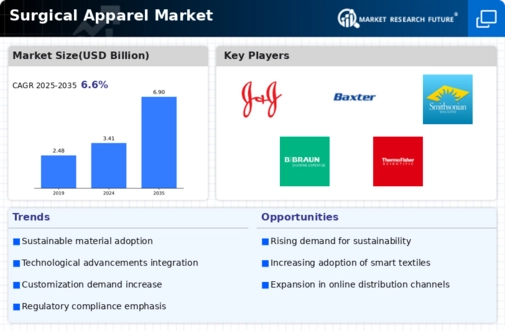Market Analysis
In-depth Analysis of Surgical Apparel Market Industry Landscape
The surgical apparel market operates within the broader healthcare industry, playing a crucial role in ensuring the safety and hygiene of medical professionals and patients during surgical procedures. Market dynamics in this sector are shaped by a combination of factors, including advancements in technology, regulatory frameworks, and the overall healthcare landscape. As the demand for surgical procedures continues to rise globally, fueled by an aging population and increased prevalence of chronic diseases, the market for surgical apparel experiences steady growth.
One significant driver of market dynamics is the continuous innovation in material technology. Manufacturers are constantly exploring new materials with improved antimicrobial properties, breathability, and comfort. This focus on innovation not only enhances the overall performance of surgical apparel but also addresses the evolving needs of healthcare professionals. Surgeons and other medical staff require garments that provide optimal protection against contaminants while allowing ease of movement and comfort during prolonged procedures.
Stringent regulations and standards imposed by health authorities also significantly influence market dynamics. Compliance with guidelines related to infection control and safety is paramount in the healthcare sector, prompting manufacturers to invest in research and development to meet or exceed these standards. As a result, the market is characterized by a competitive landscape where companies strive to differentiate themselves by adhering to the highest quality and safety standards.
Globalization and the interconnected nature of the healthcare industry contribute to the market dynamics of surgical apparel. As medical facilities expand and healthcare systems become more integrated, the demand for standardized, high-quality surgical apparel increases. Manufacturers often find themselves catering to diverse markets with varying regulatory requirements and cultural preferences, necessitating adaptability and flexibility in their product offerings.
Cost considerations are another crucial aspect shaping the market dynamics. Healthcare facilities, especially in developing economies, are often constrained by budget limitations. This prompts manufacturers to explore cost-effective production methods without compromising on the quality and safety of surgical apparel. Market players may engage in strategic partnerships or collaborations to leverage economies of scale, thereby optimizing production costs and ensuring affordability for end-users.
The COVID-19 pandemic has further impacted the dynamics of the surgical apparel market. The heightened awareness of infection control measures and the surge in demand for personal protective equipment (PPE) have accelerated market growth. The pandemic has underscored the importance of resilient and responsive supply chains to meet the sudden and unprecedented demand for surgical apparel. As a result, market players are now more focused on enhancing their production capabilities and supply chain management to navigate similar challenges in the future.









Leave a Comment